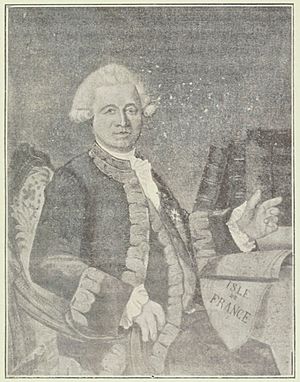Jean-Daniel Dumas facts for kids
Quick facts for kids
Jean-Daniel Dumas
|
|
|---|---|
 |
|
| Born | 24 February 1721 Montauban, France |
| Died | 2 August 1794 (aged 73) Albias, France |
| Allegiance | |
| Service/ |
French Army French Marines |
| Years of service | 1739-1750, 1768-1780 1750-1768 |
| Rank | Colonel (Marines) 1761 Maréchal de camp (Army) 1780 |
| Commands held | Town major of Quebec, 1757 Adjutant of Canadian Militia, 1757 Adjutant-general of French Marines in Canada, 1759 Commanding a brigade, 1759-1760 Commandant of Isle de France and Ile Bourbon, 1766-1768 |
| Battles/wars | War of the Austrian Succession Seven Years' War |
| Awards | Knight of the Order of St. Louis |
| Relations | Unmarried |
Jean-Daniel Dumas (born February 24, 1721 – died August 2, 1794) was a brave French officer. He played an important role in the Seven Years' War, a big conflict that involved many countries. One of his most famous moments was at the Battle of the Monongahela. Here, French and Native American forces attacked a British army led by General Edward Braddock. Dumas, along with Charles Michel de Langlade, took charge after their commander was killed early in the battle.
Contents
Early Military Life
Jean-Daniel Dumas began his military career in 1742. He joined a group called the Agenais Regiment. He fought in the War of the Austrian Succession, a major European conflict. During this time, he served in different places like Bavaria, Italy, Corsica, and Provence.
In 1750, Dumas sailed to North America. He became a captain in a company of naval troops. He was assigned to Fort Gaspareaux while it was being built. Later, in 1753, he was stationed at Fort Le Boeuf. From 1754, he moved to Fort Duquesne.
The Battle of Monongahela
On July 9, 1755, Jean-Daniel Dumas led French soldiers, local militia, and Native American allies. They faced a British army led by General Edward Braddock at the Battle of the Monongahela. The French commander, Daniel Liénard de Beaujeu, was killed at the very start of the battle.
Dumas quickly took command. He led his forces to victory against the British. This was a very important win for the French. Because of his bravery and skill, Jean-Daniel Dumas was honored. He was made a knight on March 17, 1756, when he was 35 years old.
Leading Fort Duquesne and Other Battles
After the Battle of Monongahela, Dumas took charge of Fort Duquesne. He organized several attacks with his French-Canadian and Native American allies. These raids targeted the border areas of the province of Pennsylvania.
In 1757, Dumas returned to Montreal. He then joined an expedition to capture Fort William Henry. This was another important fort during the war. In 1759, he was in Quebec during the siege of the city. He was also promoted to major general of naval troops in January 1759.
Dumas continued to fight bravely. He took part in the Battle of Sainte-Foy in the spring of 1760. He also participated in the Montreal Campaign. This campaign led to the surrender of Montreal to the British. After this, Dumas returned to France.
Later Career and Promotions
On July 17, 1766, Jean-Daniel Dumas was given a new important role. He became the first governor general of the Mascarene Islands. These islands, including Isle de France (now Mauritius) and Ile Bourbon (now Réunion), had been given to the King of France.
He later became a brigadier-general. In 1768, he was called back to France. His final promotion came in 1780. He was made a field marshal, a very high rank in the army.

